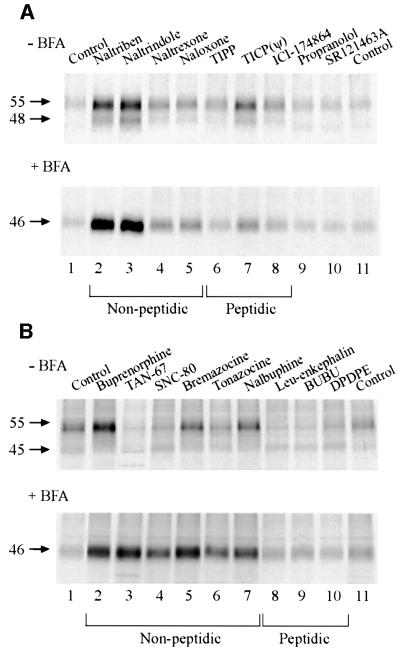Fig. 5. Both membrane-permeable opioid antagonists and agonists can function as pharmacological chaperones. HEK-293S-hδOR-FLAG cells were pulse-labeled with [35S]methionine/cysteine and chased for 6 h in the presence of 10 µM of the indicated opioid antagonists (A) or agonists (B). BFA (5 µg/ml) or the vehicle (–BFA) was added to the medium 60 min prior to labeling. Receptors were then isolated by immunoprecipitation and analyzed as described in Figure 1. The abbreviations used are: BUBU, Tyr-D-Ser[-O-C(CH3)3]-Gly-Phe-Leu-Thr-O-C(CH3)3; DPDPE, cyclic[D-Pen2,D-Pen5]enkephalin; ICI-174864, N,N-diallyl-Tyr-Aib-Aib-Phe-Leu-OH; SNC-80, (+)-4-[(αR)-α-((2S,5R)-4-allyl-2,5-dimethyl-1-piperazinyl)-3-methoxybenzyl]-N,N-diethylbenzamidine; SR121463A, 1-[4-(N-tert-butylcarbamoyl)-2- methoxybenzenesulfonyl]-5-ethoxy-3-spiro-[4-(2-morpholinoethoxy)cyclohexane]indol-2-one, fumerate; TAN-67, 2-methyl-4aα-(3-hydroxyphenyl)-1,2,3,4,4a,5,12,12aα-octahydroquinolino-[2,3,3-g]isoquinoline); TICP(ψ), Tyr-Ticψ[CH2NH]Cha-Phe-OH; TIPP, Tyr-Tic-Phe-Phe-OH.

An official website of the United States government
Here's how you know
Official websites use .gov
A
.gov website belongs to an official
government organization in the United States.
Secure .gov websites use HTTPS
A lock (
) or https:// means you've safely
connected to the .gov website. Share sensitive
information only on official, secure websites.
